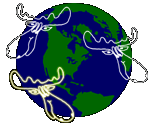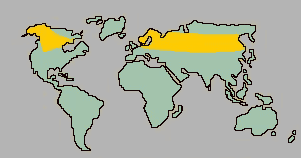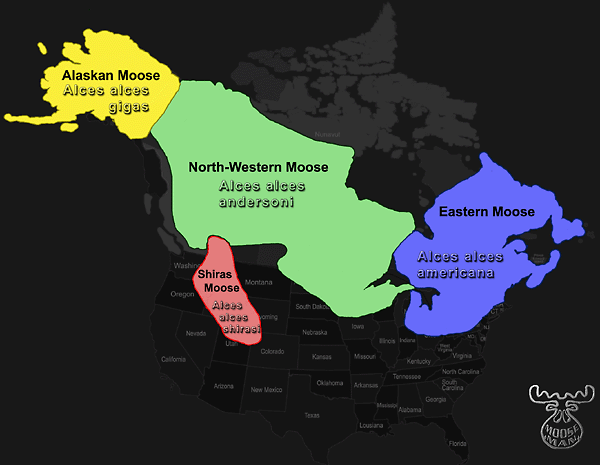 |
Where to find - Moose Habitat & Species |
 World Zones of Moose
World Zones of Moose
 |
Moose can be found in forested areas with lakes or ponds (or in those ...), streams and swamps, i.e., moist conditions. Coniferous and young mixed forests are their home. Snow cover in the winter up to 60-70cm can be seen as standard, Moose habitat is determined by the temperatures. Moose prefer zones where the summer average is around 15 °C and does not exceed 27 °C for long. The reason for this temperature dependancy: They cannot sweat and they produce additional heat by fermentation in their gut. Besides the cooling effect of water, from which moose are seldomly far away, water protects against biting insects and offers good food supply. Moose are native in nearly all Northern forest zones: The habitat is limited to the South by approximately the 50th parallel and to the North by the 67th parallel. Scientifically this is taiga, forest tundra, temperate forest and rain forest, i.e., boreal and subarctic zones. Two main areas are perfect related to vegetation and the content of
nutrients: Flooding areas, where high levels of nutrients/minerals come into the soils;
The minerals required are found in silt and loess-soils found in the northern temperate zones, which forms the main habitat of the moose. These soils, combined with usually young eco-systems, give rapid plant growth of nutrient-rich and soft plants - the perfect food for moose. |
 Moose
Home Territory
Moose
Home Territory
Moose stay resident, if they find enough nutrition. Huge parts of the North American moose have a home-range of between 5-40 km². Looking at their colleagues high up north with less food supply, the home-range can be up to 25-times that big! Alaskan moose have around 260 km² in average browsing areas.
In their home zone moose seem to have small areas with high utilization, likely those with a rich food supply. Other areas are only used for transit. Also the mating grounds can be those with high attendance.
Usually moose have their home-range not far away from the place they were born (provided that the food supply is adequate), normally not more than half a day-trip away. Cows have an average distance of their habitat from their place of birth of 8-16km, bulls exceed this normally.
Moose are found in higher elevations in summer time (higher than 1500 m) than in winter (lower than 1000m) - they may travel up to 100 km to their wintering grounds.
 Moose
Sub-Species and Their Habitat
Moose
Sub-Species and Their Habitat
All moose on Earth belong to one species (Alces alces linneaus).
(For the scientific classification of the moose in general see " Name
& Major scientific classification")
Name
& Major scientific classification")
Looking further at differentiation into sub-species, a point of controversy comes up: below you find the standard classification into a variety of sub-species, as science, respectively the discoverers, have defined it.
But newer sources question this classification, the argument being that observed differences in moose can be explained by differences in their environment. On this reasoning are only two subspecies: for this point of view see "Environmental Classification".
The following sub-species are defined depending on the geographical habitat and discoverers:
|

Click here for a larger image of the map above |
|
Area: Alaska (about 150.000), western Yukon and northwestern British Columbia The Alaska or Yukon Moose is the biggest sub-species. Bulls can get
2,50 m high at the shoulders (average 2m) and up to 3,10 m long at a weight of 1000 kg. A
full-grown bull with its tremendous antlers (about 23kg, 2 m wide) is the largest
wild animal in North
America. The bell (throat beard) is longer than that of the European moose - it can get up to 96 cm ! It is estimated, that the moose came over the Behring bridge to Alaska 350.000 years ago. Population: Estimated 170.000-220.000 |
|
|
Area: central British Columbia to northern Minnesota, Wisconsin, Michigan to western Ontario and Northwest Territories/Nunavut, Eastern Yukon Territories Largest propagation, brownish-black and medium sized. Population: Estimated 350.000-410.000 Estimated population for British Columbia: 175.000 |
|
Area: Maine (30.000, highest US density), Nova Scotia, Quebec, Newfoundland (110.000), central Ontario, Hudson bay to the Great Lakes. Expansion down to Connecticut. Mahogany-brown in color, smallest North American sub-species. After moose hunting was forbidden between 1935 and 1980 in Maine, the number of moose increased from 7.000 in 1950 to 20.000 in 1990 - a good example of how human interaction influences moose population. Also a good example for the Southerly expansion is the increase of population in Connecticut. With no attested report before 1956 (some sporadic reports starting in the early 1900s), the population increased to about 100 moose today with increasing number of sightings per year. Population: Estimated 250.000-330.000 |
|
Area: north Wyoming (e.g. 200 examples in Yellowstone National Park), north and central Idaho, western Montana, southwestern Alberta , southeastern British Columbia and western areas in Utah with high elevations, Colorado, northwestern Washington and throughout much of the Rocky Mountains A medium-sized sub-species with relatively wide nose-openings. The back is colored more pale/grayish compared to the other American sub-species. It will stand up to 175 cm at the shoulders and weigh up to 450kg. The antlers can vary between 100 and 125cm wide. The moose was named after George Shiras III, who was a politician, wildlife
photographer and conservationist from Pennsylvania, whose friend was the
disoverer E.W.Nelson. Nelson, working for the US Bureau of biological surveys,
named the moose sub-species after his friend Shiras. Population: Estimated 25.000 |
Thanks to the staff of mooseworld.com for our mutual exchange between friends of moose and their "native language support" and revision of this section.